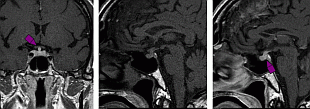ICEECE2012 Poster Presentations Clinical case reports - Pituitary/Adrenal (58 abstracts)
Central diabetes insipidus as first sign of progression to accelerated phase in a chronic myeloid leukemia patient
A. Gedik , M. Yilmaz , D. Cimrin , S. Kahraman & A. Comlekci
Dokuz Eylul University Medical Faculty, Izmir, Turkey.
Introduction: Pituitary involvement has been rarely reported during the course of hematological diseases like thalessemia, Langerhans-cell histiocytosis and lymphoma. We here present a case of chronic myeloid leukemia (CML) with pituitary involvement, in which central diabetes insipidus (DI) was the first sign of progression to accelerated phase.
Case report: A 61-year-old man was consultated by our clinic due to polyuria with 6000 ml daily urine output. His past medical history revealed CML which was in complete remission for 2 years. He had signs of dehydration, orthostatic hypotension and splenomegaly. Laboratory tests demonstrated severe hypernatremia, decreased urinary and increased serum osmolarities (Table 1). Water deprivation test was not held due to severe signs of dehydration. Desmopressin was started with a presumptive diagnosis of DI after which urine output and biochemical tests returned to normal. Pituitary MRI revealed thickened enhancing pituitary stalk and loss of the bright spot of the neurohypophysis (Figure 1). Patient was referred for hematological reevaluation. Reappearance of the Philadelphia chromosome and increased blast ratio in bone marrow was documented which showed progression from chronic remission phase into accelerated phase.
Conclusion: Diabetes Insipidus has been reported in patients with acute leukemia or myelodysplastic syndrome and almost always been associated with gravid course. Monosomy 7 and/or inv(3) have been linked with DI in some cases. Direct infiltration by the leukemic cells, hemorrhage, thrombosis and infection have been suggested as the possible factors underlying the pituitary damage. Appearance of DI during the course of hematological malignancies should alert the physician for acceleration or blastic transformation of the disease.
| Test | Result | Reference range (unit) |
| Sodium | 167 | 136–145 (mEq/l) |
| Potassium | 3.8 | 3.5–5.1 (mEq/l) |
| BUN | 20.8 | 8.4–25.7 (mg/dl) |
| Creatinine | 1.03 | 0.1.3 (mg/dl) |
| Urine osmolarity | 146 | (mOsm/kg) |
| Serum osmolarity | 299 | (mOsm/kg) |
| WBC | 10.5 | 4–10.3 (μl) |

Figure 1 Pituitary MRI.
Declaration of interest: The authors declare that there is no conflict of interest that could be perceived as prejudicing the impartiality of the research project.
Funding: This research did not receive any specific grant from any funding agency in the public, commercial or not-for-profit sector.
 }
}



